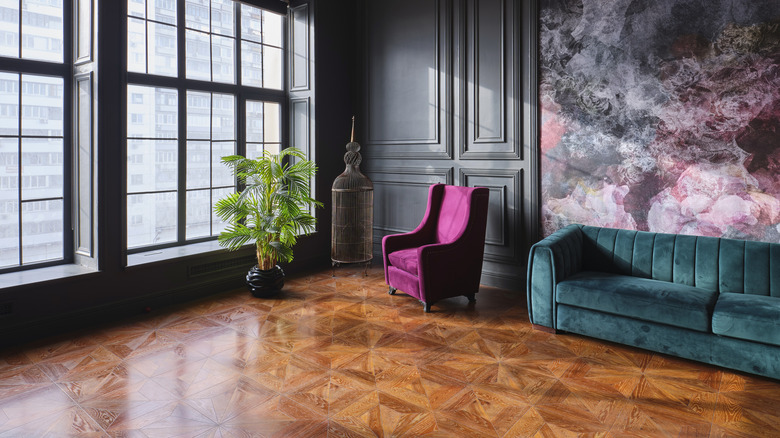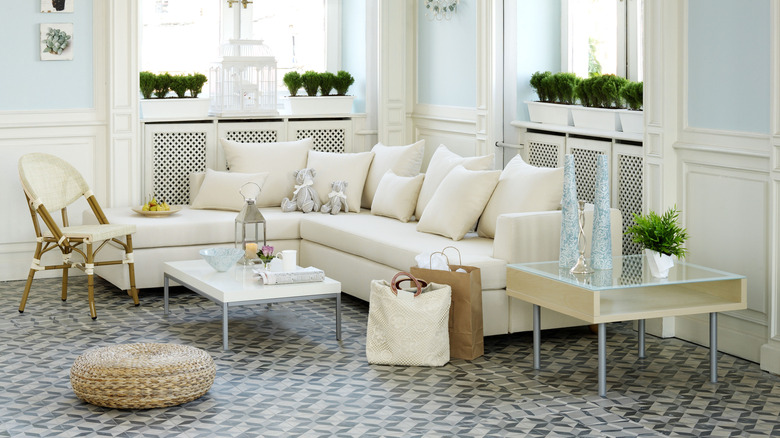Tips For Making A Patterned Floor Look Both Trendy And Timeless
Everything old is eventually new again. Perhaps that is part of the reason why traditional home decor elements from the 1800s and 1900s are coming back into style again. For example, the cottagecore design trend takes cues from the Victorian era and its over-the-top use of brocaded fabrics and lace. Another trend that has been creeping back into contemporary homes has to do with the space under your feet — that's right: the floor. Flooring is sometimes an afterthought, though your flooring is actually the keystone that anchors the rest of your home design. You won't be pairing a deep, warm cherry wood floor with bright orange fiberglass chairs, just like you probably wouldn't complement a black-and-white checkerboard tile floor with a pinstriped sofa. The floor sets the tone for your entire design scheme.
Way back when, people weren't afraid to play with a bit of pattern in their flooring. Elegant English country homes often featured sophisticated parquet floors in alluring geometric patterns. Well into the 1960s, it was common for middle-class homes to feature fun tile patterns in the kitchen and bathroom, using either stone or linoleum. Today, patterned flooring is making a comeback, and it's leaving us all with a difficult question to answer: How do you integrate patterned flooring into your home without overdoing it? It is all about balance. When you remember that your floor will be the "anchor" for your space, you can plan a layout that looks cohesive and timeless.
Looking for flooring inspiration in the trends of the past
It can be useful to look for flooring inspiration in older buildings retaining their original floors. Authenticity is very much in right now, and getting an authentic vintage look requires doing a bit of homework. While real hardwood is a timeless choice, there are ways to recreate antique parquet floors using laminate or even adhesive floor tiles. Take a look at some examples of real hardwood floors in famous old buildings, like the famous Grand Style parquet floors at the Palace of Versailles. This noteworthy geometric pattern incorporates triangles and rectangles interwoven into a repeating square motif. You can mimic this look in your own home with these 24-inch square laminate panels from Litfad or this waterproof laminate option from LL Flooring.
If you are working on a tight budget or just want to temporarily refurbish a space while you save up for bigger and better things, stick-on tiles can be a lifesaver. You don't have to compromise on style or authenticity, either. Take a look at Etsy for some true-to-form recreations of vintage flooring patterns. You can source any number of vintage-inspired tile patterns, from earthy terracotta tiles to funky, seamless midcentury-chic geometric panels. Even replicating a high-end wood look is a breeze with products like these herringbone peel-and-stick faux wood panels. Don't be afraid to be bold — at only $1 per square foot, you can go big without a massive investment.
Keep it contemporary with the right accessories
Once you've selected a bold patterned floor, how do you make sure that you don't slip into an unintentionally outdated design? The key is to accessorize with the right furnishings and rugs. Choose trendy, contemporary colored rugs to break up your space, and place them strategically around your furniture. Green, beige, and rust are all on-trend for a natural look in your living space.
Next, try solid-colored furnishings, like a simple plush white sofa to offset the busyness of your patterned floor. You may also take your wall adornments into consideration: think about leaving big windows without curtains, to draw light in and make the space look big and bright. If you do decide to use curtains, opt to decorate with a neutral-colored sheer panel that will blend in while still blocking some sun. Take your time, get creative, and don't forget to experiment and have fun with your new funky flooring.


